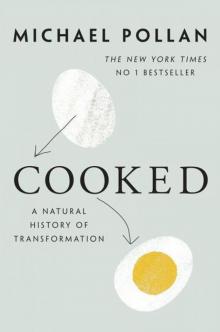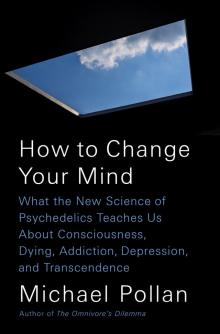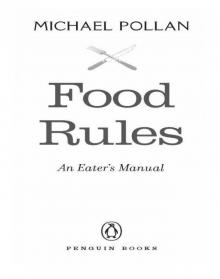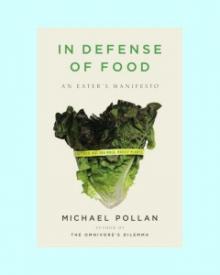- Home
- Michael Pollan
Food Rules Page 2
Food Rules Read online
Page 2
Food Rules distills this body of wisdom into sixty-four simple rules for eating healthily and happily. The rules are framed in terms of culture rather than science, though in many cases science has confirmed what culture has long known; not surprisingly, these two different vocabularies, or ways of knowing, often come to the same conclusion (as when scientists recently confirmed that the traditional practice of eating tomatoes with olive oil is good for you, because the lycopene in the tomatoes is soluble in oil, making it easier for your body to absorb). I have also avoided talking much about nutrients, not because they aren’t important, but because focusing relentlessly on nutrients obscures other, more important truths about food. Foods are more than the sum of their nutrient parts, and those nutrients work together in ways that are still only dimly understood. It may be that the degree to which a food is processed gives us a more important key to its healthfulness: Not only can processing remove nutrients and add toxic chemicals, but it makes food more readily absorbable, which can be a problem for our insulin and fat metabolism. Also, the plastics in which processed foods are typically packaged can present a further risk to our health. This is why many of the rules in this book are designed to help you avoid heavily processed foods—which I prefer to call “edible foodlike substances.”
Most of these rules I wrote, but many of them have no single author. They are pieces of food culture, sometimes ancient, that deserve our attention, because they can help us. I’ve collected these adages about eating from a wide variety of sources. (The older sayings appear in quotes.) I consulted folklorists and anthropologists, doctors, nurses, nutritionists, and dietitians, as well as a large number of mothers, grandmothers, and great-grandmothers. I solicited food rules from my readers and from audiences at conferences and speeches on three continents; I publicized a Web address where people could e-mail rules they had heard from their parents or others and had found personally helpful. A single request for rules that I posted on the New York Times’s “Well” blog resulted in twenty-five hundred suggestions. Not all of them made a whole lot of sense (“One meat per pizza” is probably not a surefire prescription for good health), but many of them did, and several are included here. Thank you to all who contributed to the project. Taken together, these rules comprise a kind of choral voice of popular food wisdom. My job has been not to create that wisdom so much as to curate it and vet it. My wager is that that voice has as much or more to teach us, and to help us right our relationship to food, than the voices of science and industry and government.
The sixty-four rules here are each accompanied by a paragraph or two of explanation, except for a few that are self-explanatory. There is no need to learn or memorize them all, because many will take you to the same place. For example, rule number 11 (“Avoid foods you see advertised on television”) and rule number 7 (“Avoid food products containing ingredients that a third-grader cannot pronounce”) are both designed to keep more or less the same highly processed foodlike products out of your cart. My hope is that a handful of these rules will prove sufficiently sticky, or memorable, that they will become second nature to you—something you do, or don’t do, without giving it a thought.
While I call them rules, I think of them less as hard-and-fast laws than as personal policies. Policies are useful tools. Instead of prescribing highly specific behaviors, they supply us with broad guidelines that should make everyday decision making easier and swifter. Armed with a general policy, like rule number 36 (“Don’t eat breakfast cereals that change the color of the milk”), you’ll find you won’t have to waste as much time reading ingredients labels and making decisions standing in the cereal aisle. Think of these food policies as little algorithms designed to simplify your eating life. Adopt whichever ones stick and work best for you.
But do be sure to adopt at least one from each of the three sections, because each section deals with a different dimension of your eating life. The first section is designed to help you “eat food,” which in the modern supermarket turns out to be a lot more difficult than you would think. These rules offer screens or filters to help you tell the real food from the edible foodlike substances you want to avoid. The second section, subtitled “Mostly plants,” offers rules to help you choose among real foods. And the third, subtitled “Not too much,” deals with how rather than what to eat and offers a series of policies designed to foster some simple everyday habits that will help you moderate your eating and enjoy it more. If those two goals sound contradictory, well, you haven’t dipped into this book yet.
PART I
What should I eat?
(Eat food.)
The rules in this section will help you to distinguish real foods—the plants, animals, and fungi people have been eating for generations—from the highly processed products of modern food science that, increasingly, have come to dominate the American food marketplace and diet. Each rule proposes a different filter for separating the one from the other, but they all share a common aim, which is to help you keep the unhealthy stuff out of your shopping cart.
1
Eat food.
These days this is easier said than done, especially when seventeen thousand new products show up in the supermarket each year, all vying for your food dollar. But most of these items don’t deserve to be called food—I call them edible foodlike substances. They’re highly processed concoctions designed by food scientists, consisting mostly of ingredients derived from corn and soy that no normal person keeps in the pantry, and they contain chemical additives with which the human body has not been long acquainted. Today much of the challenge of eating well comes down to choosing real food and avoiding these industrial novelties.
2
Don’t eat anything your great-grandmother wouldn’t recognize as food.
Imagine your great-grandmother (or grandmother, depending on your age) at your side as you roll down the aisles of the supermarket. You’re standing together in front of the dairy case. She picks up a package of Go-GURT Portable Yogurt tubes—and hasn’t a clue what this plastic cylinder of colored and flavored gel could possibly be. Is it a food or is it toothpaste? There are now thousands of foodish products in the supermarket that our ancestors simply wouldn’t recognize as food. The reasons to avoid eating such complicated food products are many, and go beyond the various chemical additives and corn and soy derivatives they contain, or the plastics in which they are typically packaged, some of which are probably toxic. Today foods are processed in ways specifically designed to get us to buy and eat more by pushing our evolutionary buttons—our inborn preferences for sweetness and fat and salt. These tastes are difficult to find in nature but cheap and easy for the food scientist to deploy, with the result that food processing induces us to consume much more of these rarities than is good for us. The great-grandma rule will help keep most of these items out of your cart.
Note: If your great-grandmother was a terrible cook or eater, you can substitute someone else’s grandmother—a Sicilian or French one works particularly well.
The next several rules refine this strategy by helping you navigate the treacherous landscape of the ingredients label.
3
Avoid food products containing ingredients that no ordinary human would keep in the pantry.
Ethoxylated diglycerides? Cellulose? Xanthan gum? Calcium propionate? Ammonium sulfate? If you wouldn’t cook with them yourself, why let others use these ingredients to cook for you? The food scientists’ chemistry set is designed to extend shelf life, make old food look fresher and more appetizing than it really is, and get you to eat more. Whether or not any of these additives pose a proven hazard to your health, many of them haven’t been eaten by humans for very long, so they are best avoided.
4
Avoid food products that contain high-fructose corn syrup.
Not because high-fructose corn syrup (HFCS) is any worse for you than sugar, but because it is, like many of the other unfamiliar ingredients in packaged foods, a reliable marker for a food pro
duct that has been highly processed. Also, high-fructose corn syrup is being added to hundreds of foods that have not traditionally been sweetened—breads, condiments, and many snack foods—so if you avoid products that contain it, you will cut down on your sugar intake. But don’t fall for the food industry’s latest scam: products reformulated to contain “no HFCS” or “real cane sugar.” These claims imply these foods are somehow healthier, but they’re not. Sugar is sugar.
5
Avoid foods that have some form of sugar (or sweetener) listed among the top three ingredients.
Labels list ingredients by weight, and any product that has more sugar than other ingredients has too much sugar. (For an exception to this rule, see rule 60, regarding special occasion foods.) Complicating matters is the fact that, thanks to food science, there are now some forty types of sugar used in processed food, including barley malt, beet sugar, brown rice syrup, cane juice, corn sweetener, dextrin, dextrose, fructo-oligosaccharides, fruit juice concentrate, glucose, sucrose, invert sugar, polydextrose, sucrose, turbinado sugar, and so on. To repeat: Sugar is sugar. And organic sugar is sugar too. As for noncaloric sweeteners such as aspartame or Splenda, research (in both humans and animals) suggests that switching to artificial sweeteners does not lead to weight loss, for reasons not yet well understood. But it may be that deceiving the brain with the reward of sweetness stimulates a craving for even more sweetness.
6
Avoid food products that contain more than five ingredients.
The specific number you adopt is arbitrary, but the more ingredients in a packaged food, the more highly processed it probably is. Note 1: A long list of ingredients in a recipe is not the same thing; that’s fine. Note 2: Some products now boast, somewhat deceptively, about their short ingredient lists. Häagen-Dazs has a new line of ice cream called “five.” Great—but it’s still ice cream. Same goes for the three-ingredient Tostitos corn chips advertised by Frito-Lay—okay, but they’re still corn chips. In such cases, apply rule 60 for dealing with treats and special occasion foods.
7
Avoid food products containing ingredients that a third-grader cannot pronounce.
Basically the same idea, different mnemonic. Keep it simple!
8
Avoid food products that make health claims.
This sounds counterintuitive, but consider: For a product to carry a health claim on its package, it must first have a package, so right off the bat it’s more likely to be a processed rather than a whole food. Then, only the big food manufacturers have the where-withal to secure FDA-approved health claims for their products and then trumpet them to the world. Generally, it is the products of modern food science that make the boldest health claims, and these are often founded on incomplete and often bad science. Don’t forget that margarine, one of the first industrial foods to claim it was more healthful than the traditional food it replaced, turned out to contain transfats that give people heart attacks. The healthiest food in the supermarket—the fresh produce—doesn’t boast about its healthfulness, because the growers don’t have the budget or the packaging. Don’t take the silence of the yams as a sign they have nothing valuable to say about your health.
9
Avoid food products with the wordoid “lite” or the terms “low-fat” or “nonfat” in their names.
The forty-year-old campaign to create low-and nonfat versions of traditional foods has been a failure: We’ve gotten fat on low-fat products. Why? Because removing the fat from foods doesn’t necessarily make them nonfattening. Carbohydrates can also make you fat, and many low- and nonfat foods boost the sugars to make up for the loss of flavor. Also, by demonizing one nutrient—fat—we inevitably give a free pass to another, supposedly “good,” nutrient—carbohydrates in this case—and then proceed to eat too much of that instead. Since the low-fat campaign began in the late 1970s, Americans actually have been eating more than 500 additional calories per day, most of them in the form of refined carbohydrates like sugar. The result: The average male is seventeen pounds heavier and the average female nineteen pounds heavier than in the late 1970s. You’re better off eating the real thing in moderation than bingeing on “lite” food products packed with sugars and salt.
10
Avoid foods that are pretending to be something they are not.
Imitation butter—aka margarine—is the classic example. To make something like nonfat cream cheese that contains neither cream nor cheese requires an extreme degree of processing; such products should be labeled as imitations and avoided. The same rule applies to soy-based mock meats, artificial sweeteners, and fake fats and starches.
11
Avoid foods you see advertised on television.
Food marketers are ingenious at turning criticisms of their products—and rules like these—into new ways to sell slightly different versions of the same processed foods: They simply reformulate (to be low-fat, have no HFCS or transfats, or to contain fewer ingredients) and then boast about their implied healthfulness, whether the boast is meaningful or not. The best way to escape these marketing ploys is to tune out the marketing itself, by refusing to buy heavily promoted foods. Only the biggest food manufacturers can afford to advertise their products on television: More than two thirds of food advertising is spent promoting processed foods (and alcohol), so if you avoid products with big ad budgets, you’ll automatically be avoiding edible foodlike substances. As for the 5 percent of food ads that promote whole foods (the prune or walnut growers or the beef ranchers), common sense will, one hopes, keep you from tarring them with the same brush—these are the exceptions that prove the rule.
Bogus health claims and faulty food science have made supermarkets particularly treacherous places to shop for real food, which suggests the next two rules.
12
Shop the peripheries of the supermarket and stay out of the middle.
Most supermarkets are laid out the same way: Processed food products dominate the center aisles of the store, while the cases of mostly fresh food—produce, meat and fish, dairy—line the walls. If you keep to the edges of the store you’ll be much more likely to wind up with real food in your shopping cart. This strategy is not foolproof, however, since things like high-fructose corn syrup have crept into the dairy case under the cover of flavored yogurts and the like.
13
Eat only foods that will eventually rot.
What does it mean for food to “go bad”? It usually means that the fungi and bacteria and insects and rodents with whom we compete for nutrients and calories have gotten to it before we did. Food processing began as a way to extend the shelf life of food by protecting it from these competitors. This is often accomplished by making the food less appealing to them, by removing nutrients from it that attract competitors, or by removing other nutrients likely to turn rancid, like omega-3 fatty acids. The more processed a food is, the longer the shelf life, and the less nutritious it typically is. Real food is alive—and therefore it should eventually die. (There are a few exceptions to this rule: For example, honey has a shelf life measured in centuries.) Note: Most of the immortal foodlike substances in the supermarket are found in the middle aisles.
14
Eat foods made from ingredients that you can picture in their raw state or growing in nature.
Read the ingredients on a package of Twink-Ries or Pringles and imagine what those ingredients actually look like raw or in the places where they grow: You can’t do it. This rule will keep all sorts of chemicals and foodlike substances out of your diet.
15
Get out of the supermarket whenever you can.
You won’t find any high-fructose corn syrup at the farmers’ market. You also won’t find any elaborately processed food products, any packages with long lists of unpronounceable ingredients or dubious health claims, anything microwaveable, or, perhaps best of all, any old food from far away. What you will find are fresh, whole foods harvested at the peak of their taste and nutritional qualit
y—precisely the kind your great-grandmother, or even your Neolithic ancestors, would easily recognize as food. The kind that is alive and eventually will rot.
16
Buy your snacks at the farmers’ market.
You’ll find yourself snacking on fresh or dried fruits and nuts—real food—rather than chips and sweets.
17
Eat only foods that have been cooked by humans.
If you’re going to let others cook for you, you’re much better off if they are other humans, rather than corporations. In general, corporations cook with too much salt, fat, and sugar, as well as with preservatives, colorings, and other biological novelties. They also aim for immortality in their food products. Note: While it is true that professional chefs are generally humans, they often cook with large amounts of salt, fat, and sugar too, so treat restaurant meals as special occasions.
Following are a few useful variants on the human-cooked-food rule.
18
Don’t ingest foods made in places where everyone is required to wear a surgical cap.
.
19
If it came from a plant, eat it; if it was made in a plant, don’t.
.
20
It’s not food if it arrived through the window of your car.
.
21
It’s not food if it’s called by the same name in every language. (Think Big Mac, Cheetos, or Pringles.)

 A Place of My Own: The Education of an Amateur Builder
A Place of My Own: The Education of an Amateur Builder Cooked: A Natural History of Transformation
Cooked: A Natural History of Transformation The Omnivore's Dilemma
The Omnivore's Dilemma How to Change Your Mind
How to Change Your Mind Food Rules
Food Rules In Defense of Food
In Defense of Food A Place of My Own
A Place of My Own